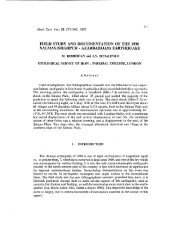PDF COPY - Manuel berberian
PDF COPY - Manuel berberian
PDF COPY - Manuel berberian
Create successful ePaper yourself
Turn your PDF publications into a flip-book with our unique Google optimized e-Paper software.
BERBERIAN AND KING 243<br />
Cretaceous Khami Group (James and Wynd 1965) were<br />
laid down in a steadily subsiding basin in the Zagros.<br />
The Jurassic carbonate platform extended from the<br />
High-Zagros to northern central Arabia and the climate<br />
seemed to be more humid than previously (Murris<br />
1978). The late Jurassic movements were of minor<br />
tectonic importance, causing slight and short-lived<br />
marine regression of the sea. This regression laid down a<br />
sheet of anhydrite (Hith Anhydrite) from the Arabian<br />
platform to the present foothills of the Zagros, indicating<br />
an arid climate (Murfis 1978). In the interior of the<br />
Zagros basin, near Shiraz, there was more or less<br />
continuous sedimentation during late Jurassic and early<br />
Cretaceous times (James and Wynd 1965; Setudehnia<br />
1978).<br />
As a result of the late Jurassic movements, the whole<br />
western part of Arabia was uplifted and heavily eroded.<br />
Subsequent movements associated with the reactivation<br />
of faults led to the extrusion of basalts in northwest<br />
Arabia until Albian times (Saint-Marc 1978).<br />
II. 5---CRETACEOUS MOVEMENTS<br />
The Cretaceous System was introduced to Iran by<br />
marine transgression over most of the country. In multibranched<br />
rifts, deep-water sediments, diabasic pillow<br />
lava, and continental slope deposits accumulated. Following<br />
the Lower and Middle Cretaceous marine carbonate<br />
deposits, the whole region underwent strong<br />
deformation towards the end of the Cretaceous Period<br />
(Table 2). The Cretaceous movements are divided here<br />
into three phases: the late Neocomian-Albian (118-105<br />
Ma), late Santonian (77 Ma), and late Maastrichtian<br />
Ma). They were associated with episodic imbrication<br />
and ophiolite-radiolarites were emplaced along the<br />
Sevan-Akera (and Vedi) belt in the Little Caucasus, the<br />
High-Zagros-Oman belt, the Central Iranian belts, and<br />
in the Makran region (Figs. 1, 6, and 14). The Iranian<br />
Mesozoic ophiolites have been explained either as remnants<br />
of a large oceanic crust (Pilger 1971; Takin 1972;<br />
Forster et al. 1972; Ricou 1974; Glennie et al. 1974;<br />
Haynes and McQuillan 1974; Stocklin 1974, 1977;<br />
Stoneley 1974, 1975; Lensch et al. 1975; Pilger and<br />
Rosier 1976; Alavi-Tehrani 1975, 1976, 1977; and<br />
Khain 1977, or as narrow intracratonic Red Sea type<br />
rifts (Sabzehei 1974; Nabavi 1976; Beloussov and<br />
Sholpo 1976; Hushmandzadeh 1977). Stoneley (1974)<br />
and Stocklin (1974) emphasized the existence of two<br />
ophiolite-m61ange belts. Stocklin (1977) divided the<br />
Middle Eastern Cretaceous ophiolite-radiolafite belts<br />
into two subbelts: the southern or outer subbelt (the<br />
’High-Zagros-Oman’ ophiolite-radiolarite in this<br />
study) south of the Main Zagros reverse fault line, and<br />
the northern or inner subbelt (the ’Central Iranian’<br />
separated ophiolite-m61ange belts; Figs. 1 and 14).<br />
H.5.1--Lower Cretaceous movements (118-105 Ma<br />
H.5.1a--The Zagros basin<br />
Despite the continuous Jurassic--Cretaceous marine<br />
carbonate sedimentation in Shiraz and northern Khuzestan<br />
area, the Cretaceous sequence of the Zagros covers<br />
the underlying Jurassic sediments (Surmeh, Hith, or<br />
Gotnia Formations) disconformably (the late Jurassic<br />
disconformity) with deposition of the Fahliyan (Neocomian-Aptian)<br />
and Gadvan (Barremian-Aptian)<br />
marine carbonates over the greater part of the Zagros<br />
(Table 2). In Lorestan and northwest Khuzestan,<br />
Lower Cretaceous grey-black radiolaria-bearing shales<br />
and deep-water argillaceous limestone (Garau Formation)<br />
were deposited disconformably over the Jurassic<br />
Gotnia anhydrite. The basin shallows towards Arabia<br />
(Murris 1978). The siltstone, sandstone, and glauconite<br />
found at the upper part of the Fahliyan Formation, and<br />
the strongly iron-stained sandy and glauconitic sediments<br />
on top of the Dariyan Formation indicate a period<br />
of regression, emergence, and erosion at the end of<br />
Aptian time and an ’Aptial-Albian (105 Ma) disconformity’<br />
in the Fars area (James and Wynd 1965;<br />
Setudehnia 1978; see Table 2). A widespread emergence<br />
is reported from Arabia during Albian time, but<br />
was followed by the Cenomanian Wasia (sandstoneshale)<br />
Formation (Powers 1968).<br />
ll.5.1b---Central Iran during Early Cretaceous time<br />
The Lower Cretaceous rocks in Central Iran are<br />
detrital limestone, reef limestone (Aptian Tiz Kuh<br />
Formation, Stocklin 1972), marl, shale (Biabanak<br />
Shale, Stocklin 1972), and volcanics, frequently intermpted<br />
by conglomerates and red beds. Large sedimentary<br />
gaps and unconformities reflect an unstable sedimentary<br />
environment in Central Iran (Table 2).<br />
lI.5.1c--Little Caucasus (northwest Iran) during<br />
Early Cretaceous time<br />
The extensive Jurassic and Cretaceous volcanics in<br />
the Great and Little Caucasus, northwest Iran, show an<br />
apparently subduction related variation of alkalinity.<br />
The K20/Na20 ratio in comparable rocks north of the<br />
Sevan-Akera ophiolite belt (Pontian-Transcaucasian<br />
island arc) also indicates subduction (Adamia et al.<br />
1977). The Sevan-Akera ocean was consumed during<br />
late Neocomian-Albian time (118-105 Ma; Knipper and<br />
Sokolov 1974; Adamia et al. 1977), when northwestern<br />
Shevchenko and Rezanov (1976); Yegorkina et al. (1976); Berberian (1976a,b); Huber (1978); Saint-Marc (1978);<br />
Setudehnia (1978); Afshar-Harb (1979); Berberian and Berberian (1980); Berberian (1981); and all available data<br />
the Geological and Mineral Survey of Iran to 1980. Lambert Conformal Conic Projection.







